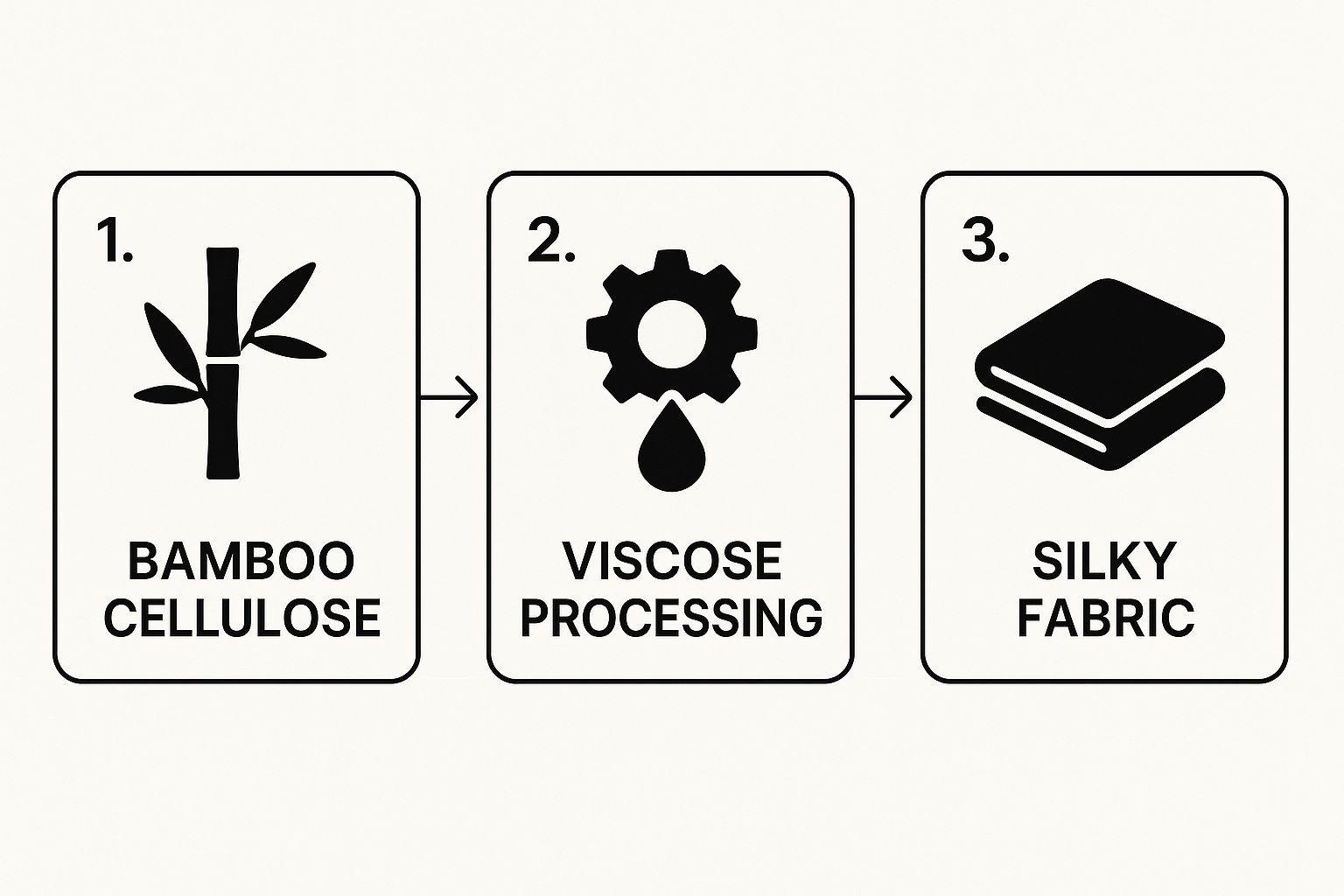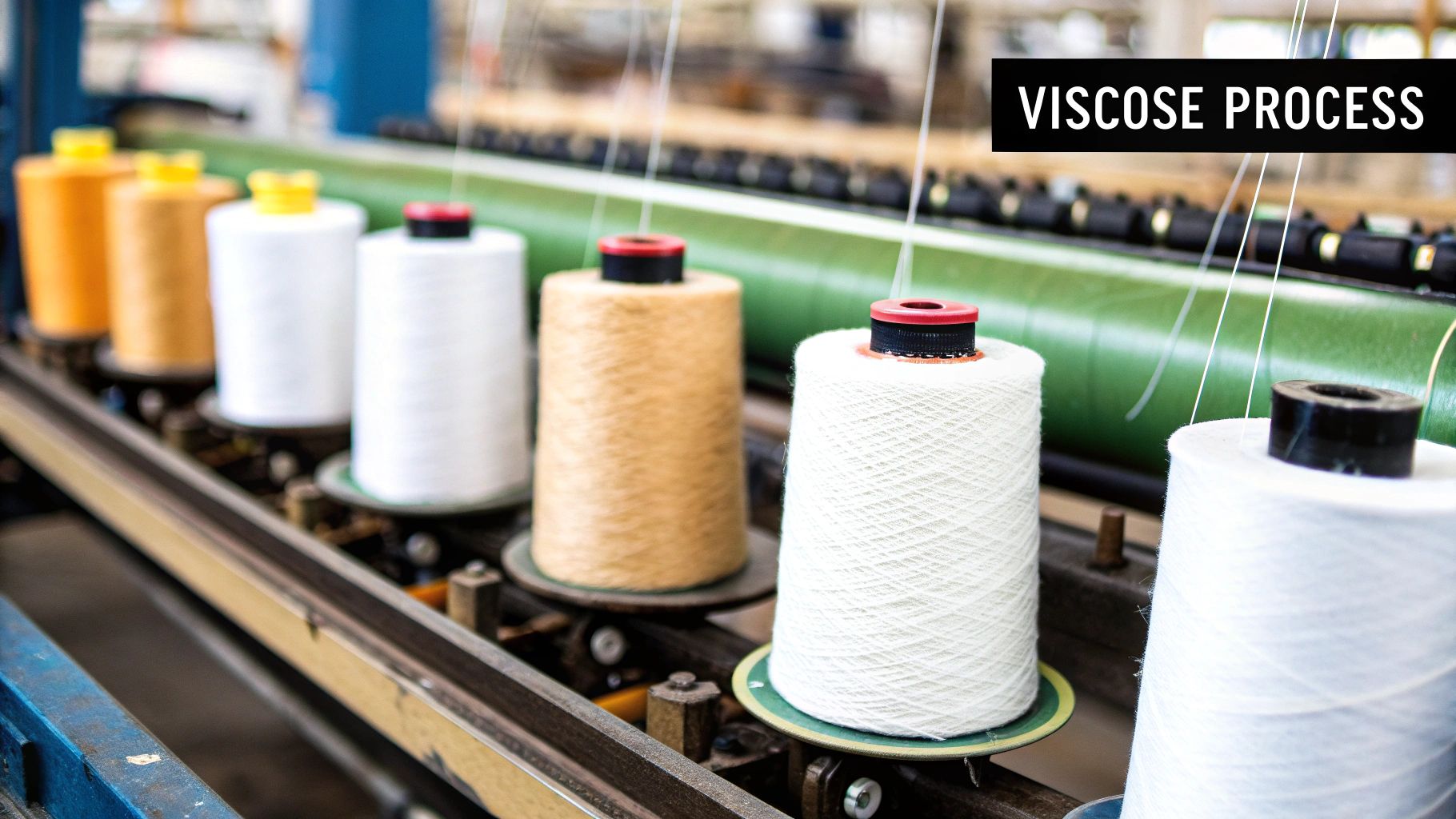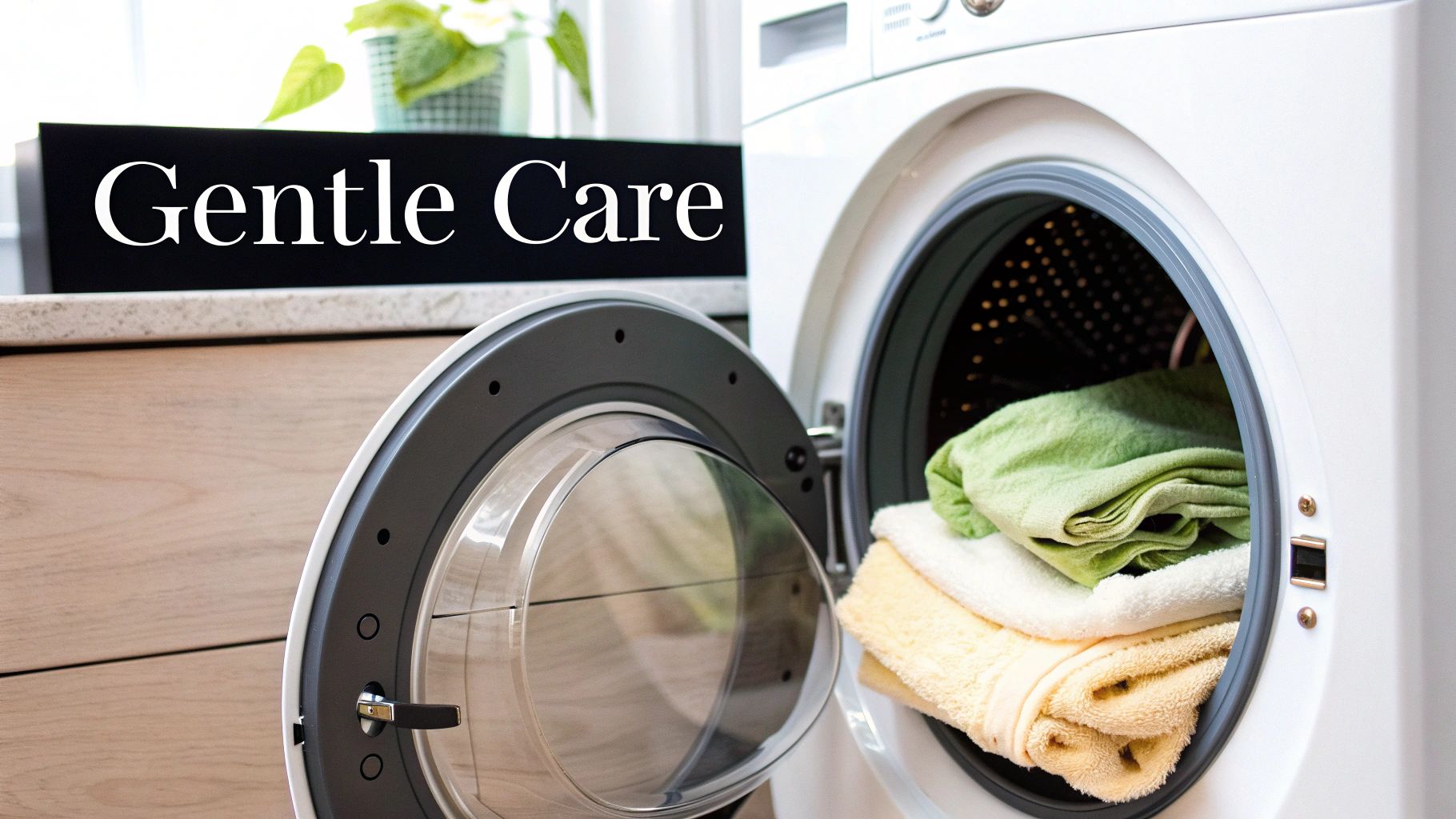Have you ever wondered how a tough, woody bamboo stalk transforms into fabric so soft it rivals silk? If you've seen "viscose from bamboo" on the labels of luxurious bedding, you've encountered this textile magic. Understanding what is viscose from bamboo is simple: it's a premium fabric made by breaking down natural bamboo pulp and regenerating it into silky, smooth fibres.
This semi-synthetic material, a type of rayon, is celebrated for its incredible softness, breathability, and moisture-wicking properties, making it a game-changer for comfortable sleep.
The Journey from Plant to Silky Fabric
Viscose from bamboo is a semi-synthetic fibre. This means it starts with a natural source—bamboo—but requires a manufacturing process to become the textile we know and love.
Think of it like making paper from trees. The essential bamboo pulp is extracted and then completely reformed. The plant's cellulose is dissolved and then regenerated into a soft, durable thread perfect for weaving into premium textiles like our bamboo sheet sets. This process is exactly what gives the final fabric its signature qualities.
Why Bamboo Viscose Stands Out
So, what makes this fabric so special? It all comes down to a few key features that have a real impact on your comfort and sleep quality.
- Exceptional Softness: The fibres are naturally round and smooth, which is why the fabric feels so silky and doesn't irritate the skin.
- High Breathability: It’s a wonderfully breathable material, allowing air to circulate freely. This helps regulate your body temperature for a far more comfortable night's sleep.
- Moisture-Wicking: The fabric is fantastic at pulling moisture away from the skin, keeping you feeling dry and fresh all night long.
The infographic below gives you a bird's-eye view of how woody bamboo is turned into that finished, silky-smooth fabric.

As you can see, it's a multi-step journey from a natural resource to a luxury textile. Understanding this process is the first step to appreciating why viscose from bamboo is such a game-changer for bedding.
Bamboo Viscose at a Glance
This table gives you a quick snapshot of the key characteristics of viscose from bamboo, giving you an easy-to-read overview.
| Characteristic | Description |
|---|---|
| Material Type | Semi-synthetic (regenerated cellulose fibre) |
| Source | Bamboo pulp |
| Feel | Silky, smooth, and exceptionally soft |
| Breathability | High, allows for excellent air circulation |
| Moisture Control | Excellent moisture-wicking properties |
| Durability | Strong and long-lasting when cared for properly |
These unique traits combine to create a fabric that doesn't just feel good—it performs brilliantly, especially for a great night's sleep.
How Is Viscose From Bamboo Actually Made?
It’s hard to imagine that the tough, woody bamboo stalk can become buttery-soft bedding. The transformation is a fascinating blend of nature and ingenuity, turning a rigid plant into a textile famous for its luxurious feel. The journey starts in responsibly managed forests where bamboo is harvested.
First, the harvested bamboo is crushed and broken down into a raw pulp. This pulp is packed with cellulose, the natural polymer that makes up the plant's structure. Think of it as preparing the key ingredient for a recipe—getting the essential material ready for the next stage.

The Viscose Process Explained
Here’s where the real transformation happens. The bamboo pulp is dissolved in a chemical solution, often sodium hydroxide and carbon disulfide, creating a thick, honey-like liquid called viscose.
At this point, the original structure of the bamboo is gone. The process regenerates the cellulose into a completely new form, which is why viscose is technically known as a 'regenerated cellulose fibre'.
This syrupy liquid is then forced through tiny holes, like a showerhead, into another chemical bath that solidifies the liquid into fine, silky threads. These threads are washed, treated, and spun into yarn, ready to be woven into the beautiful fabric used in premium bedding. This detailed process is what creates that signature softness you can learn more about in our complete guide to bamboo sheets.
Why Closed-Loop Systems Matter
A big part of modern textile production is its environmental footprint. In the past, the chemicals used in the viscose process were a major concern. Today, however, responsible manufacturers are adopting a closed-loop system.
This much smarter method ensures that:
- Up to 99.5% of the chemicals and water are captured and recycled for reuse.
- Waste is kept to an absolute minimum, stopping harmful substances from entering the environment.
- The entire process becomes far more sustainable from start to finish.
By looking for brands committed to these modern, responsible practices, you can enjoy the incredible comfort of bamboo viscose with greater peace of mind.
Why Bamboo Viscose Is a Game Changer for Your Home
So, we've walked through how this unique fabric is made, but what does that actually mean for you? Let's get into why viscose from bamboo has become a go-to choice for home textiles, especially bedding. The real story isn't just its eco-friendly beginnings; it's about how it transforms your nightly comfort.
It’s the unique blend of incredible softness, practical performance, and wellness benefits that really makes it stand out from the crowd.
Unmatched Softness and Comfort
The first thing you'll notice about bamboo viscose is its unbelievable softness. The individual fibres are naturally round and smooth, which translates to a silky, fluid texture often compared to premium materials like silk.
Unlike cotton fibres, which can have rougher edges under a microscope, bamboo viscose glides smoothly across your skin without friction. This gives the fabric its signature luxurious feel, turning your bed into a true sanctuary. It’s a difference you can feel the moment you slip into our best-selling bamboo sheets.
Superior Performance for Better Sleep
Beyond just feeling amazing, bamboo viscose is a powerhouse performer. Its natural structure helps tackle some of the most common sleep disruptors, like overheating and night sweats.
Here’s how it helps you sleep better:
- Excellent Breathability: The fabric’s weave allows air to flow freely, which stops heat from getting trapped under the covers.
- Moisture-Wicking: It actively pulls moisture away from your skin and helps it evaporate fast, keeping you comfortably dry all night.
- Temperature Regulating: This one-two punch of breathability and moisture-wicking means the fabric helps keep you cool when it's hot and cosy when it's cool.
A key advantage is its absorbency; research shows bamboo viscose can hold up to three times its weight in water. This exceptional moisture management is why it's so effective at keeping you comfortable.
Finally, bamboo viscose is naturally hypoallergenic and has antibacterial qualities. This makes it an ideal choice for anyone with sensitive skin, allergies, or asthma, helping to create a cleaner, healthier place to rest.
Is Bamboo Viscose Genuinely an Eco-Friendly Choice?
When you’re trying to shop consciously, the story behind a product’s sustainability matters. So, where does bamboo viscose actually stand? The honest answer is that its eco-friendliness depends on two things: the incredible raw material and the chemical process required to transform it.
Let's start with the plant itself, because bamboo is a superstar of sustainability. It shoots up incredibly fast, needs very little water, and thrives without pesticides or fertilisers. Its rapid growth makes it a wonderfully renewable resource—a massive tick in the box.
The Plant vs. The Process
But the green credentials of the bamboo plant are only half the story. The journey from a tough stalk into a silky fabric involves that chemical-heavy viscose process we talked about earlier. If these chemicals aren't handled responsibly, they can cause environmental harm. This is where your power as a shopper comes into play.
Thankfully, modern manufacturing has changed the game with closed-loop production systems. Think of it like a self-contained recycling system for the factory. These advanced setups capture, clean, and reuse almost all the water and chemicals, which drastically cuts down on waste and environmental impact.
The key takeaway is this: the eco-friendliness of bamboo viscose hinges heavily on how it's made, not just what it's made from. Choosing brands that are transparent about their manufacturing is crucial.
What to Look For as a Consumer
To make an informed choice, you need to know what signals responsible production. Here are a few things to keep an eye out for:
- OEKO-TEX Certification: This label is your assurance that the final product is free from a long list of harmful substances and is safe for your skin.
- FSC Certification: The Forest Stewardship Council (FSC) certifies that the bamboo is harvested from responsibly managed forests that protect biodiversity.
- Brand Transparency: Look for companies that openly share details about their supply chain and their commitment to closed-loop systems. To explore other great options, check out our guide on the top eco-friendly bedding materials for 2025.
By looking for these markers, you can feel confident that your purchase aligns with your values. Understanding the principles of green cleaning can also help you create a healthier home and planet.
How to Care for Your Bamboo Viscose Bedding
To keep that silky, soft feeling for the long haul, a little bit of special care goes a long way. While the fabric is surprisingly durable, its fine fibres need a gentle touch to stay at their best.
The golden rule? Avoid high heat. High temperatures are the enemy of these delicate fibres, causing them to shrink and weaken over time. Always wash on a cold, gentle cycle to preserve the fabric's beautiful texture and strength.

Simple Washing and Drying Steps
Keeping your sheets in pristine condition is easy. Just stick to these dos and don'ts.
- Do use a mild, liquid laundry detergent. Powdered detergents can sometimes be harsh and may not dissolve fully.
- Don't use bleach or fabric softeners. These aggressive chemicals break down bamboo’s natural fibres, ruining their softness and moisture-wicking abilities.
- Do wash sheets separately from rougher items like towels or denim to prevent pilling from friction.
When it comes to drying, line drying in the shade is best. If you use a machine, choose the lowest heat setting possible or a no-heat, tumble-only setting. Over-drying with high heat is the fastest way to damage the fibres.
Pro Tip: Pre-soak your sheets in cool water with a small amount of gentle detergent for an hour. This works wonders to lift away body oils without resorting to a harsh wash cycle.
Following these tips will ensure your bedding stays as luxurious as the day you brought it home. For more details, check our guide on how to care for your bamboo sheets so they last for years.
Common Questions About Viscose from Bamboo
Even with a detailed rundown, it's natural to have a few more questions. Let's tackle some common queries to help you feel totally confident about this fantastic fabric.
Is Viscose From Bamboo the Same as Rayon?
Yes, in a way. Think of rayon as the family name for fabrics made from regenerated cellulose. Viscose from bamboo is a specific type of rayon, distinguished by the fact that it starts its life as the fast-growing bamboo plant.
So, while all bamboo viscose is a type of rayon, not all rayon is made from bamboo.
How Does It Compare to Cotton?
While cotton is a classic, bamboo viscose offers a more luxurious experience. It's noticeably softer with a silky drape that most people compare to high-end fabrics. It also outperforms cotton in breathability and moisture-wicking, making it a game-changer for regulating your temperature at night.
- Feel: Bamboo viscose is incredibly smooth and silky. Cotton's feel varies from soft to crisp.
- Breathability: Bamboo viscose is far more breathable, a massive plus for hot sleepers.
- Moisture Management: Bamboo is a champion at pulling moisture away from your skin.
- Sustainability: The bamboo plant is a more rapidly renewable resource than cotton.
Is Bamboo Viscose Good for Sensitive Skin?
Absolutely. The fibres in bamboo viscose are naturally smooth and round, so there are no jagged edges to irritate your skin. The fabric glides over your body instead of causing friction.
Its naturally hypoallergenic and antibacterial properties make it a top-tier choice for anyone with allergies, eczema, or sensitive skin.
This gentleness is why it’s a popular choice for baby apparel in Australia, as confirmed by this market analysis, which highlights consumer demand for soft, non-irritating fabrics.
For more in-depth answers, you can dive into our full list of frequently asked questions about bamboo bedding.
Final Thoughts: Is Bamboo Viscose Right for You?
Viscose from bamboo offers a unique combination of luxury, performance, and potential sustainability. Its unparalleled softness, temperature-regulating properties, and hypoallergenic nature make it an excellent choice for anyone seeking a better night's sleep. By choosing products from brands that prioritize responsible, closed-loop manufacturing, you can enjoy this incredible fabric with confidence.
Ready to feel the difference for yourself? Discover our premium bamboo bedding and transform your sleep into a restorative escape.

